Korfball drills
This is an isolated drill to practice dynamic rebounding.
- Players have to estimate from the movement where the ball will end up and grab it as fast as possible.
- The ball starts under the basket and is thrown to the player in front of the post.
- He shoots.
- The player in front of the post runs to the cap and back and tries to catch the ball within 1 bounce.
- When the rebounder has succeeded in catching the ball after at most one bounce, he can shoot again.
- Move the cap further away.
- Challenge players to catch the ball without a bounce.
- You will do this task in pairs.
- Use a basket for each pair.
- Put 4 hats around the basket in a square about 1.5 meters from the basket. (the basket is in the middle)
- Stand in between the 2 hats in front of the basket.
- Shoot to score.
- The person under the basket names a colour and you tap on that colour.
- Go back between the 2 hats in front of the basket.
- If you have scored, you don't have to run to a colour.
- Do this until someone has scored 5.
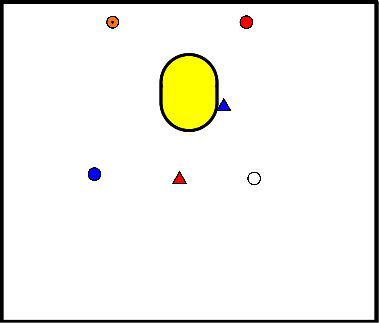
- Players learn not to throw a ball to the passer and then wait for the ball to be caught, but to run after it immediately.
- The ball is thrown to the basket.
- Immediately after throwing the ball, run after it to the basket.
- Goal is to be past the line before the ball is caught.
- Then get the ball back and shoot.
- The line makes the assignment concrete.
- Depending on the team, this may or may not be necessary.
- Variation 1:
- The ball starts under the basket, is outplayed and immediately thrown back.
- Variation 2:
- Working with an opponent.
- This opponent does not run with the ball to the basket (because that would not work in an exercise where the breakthrough is the only option), but does ensure that the attacker has to run around something.
Rules explain:
- The person taking it stands with 1 foot exactly behind the dot and the other foot stands behind the perpendicular line on the center line, from the dot.
- Everyone stands outside the imaginary line.
- Attackers stand 2.5 metres from each other.
- Defenders stand 2.5 metres from the dot, but do not have to.
- When person with ball moves, defenders may enter circle, attackers only when ball has been touched by person or is outside circle.
- Persons under the post have their feet on the same side of the post.
- An attacker or defender may not place his foot between those of the opponent.
- Defender always stands between attacker and post, except under the post when attacker is against the post.
Everyone stands in base position.
Learn variations:
- Play ball back to the person who took it out.
- The person who takes the ball decides by looking at the defenders if he passes to the side or under the basket.
- Ball is played to player moving away under the basket.
- 2 pawns/covers for the pole at about 8 meters.
- The pawns are next to each other with about 2/3 meters between them.
- The goal is to run back and forth between the pawns and to tap the pawns.
- After x number of times the person who was between the pawns has to make a pass.
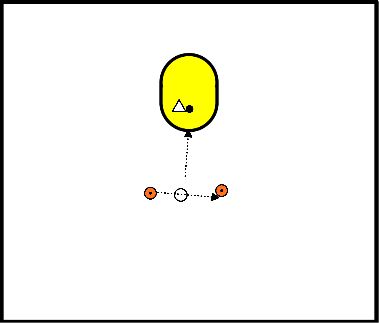
Basic rules:
- The attackers' first shot is 'free'.
- It may not be defended.
- Take the first shot, each attacker tries to stay in possession of the ball.
- If the defender takes the ball after the first shot, the attempt is over.
- If the defender does not take the ball after the first shot, the defender must try to prevent the second shot as soon as possible.
- If the attackers get the ball after the first shot, they may play freely.
- The attacker has, after the first shot, two choices: shoot himself or get the assist
- The exercise lasts a maximum of 10 seconds.
- Forces to act fast.
Task:
- Try to stay in possession of the ball after the first free shot by one of the attackers.
- If you don't, and the defender grabs the ball, your attempt is over.
- If you do, you can play freely (3-1 or 2-2).
- If a goal is scored or the ball is intercepted, the attempt is over.
- After each attempt, the attackers start at a pawn and another attacker takes the first shot.
- After 3 attempts, it is changeover time.
Forms of play:
- 2-2, then two of the attackers are always defenders and everyone starts at their own pawn.
- 4-2 or 4-3, next to the attacker who makes the shot, no one is a defender.
- After the shot, anyone can be defended.
- 4-4: There is one defender and one attacker on each teammate.
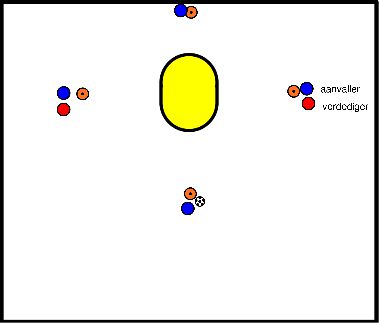
- Try to bounce through 'the forest' without the 'trees' knocking the ball away with their 'branches', then score in the baskets behind the forest.
- Who has scored the most goals?
- Step 1:
- You may occasionally grip the ball with two hands.
- Step 2:
- You may occasionally bounce the ball with 2 hands.
- Step 3:
- You must do everything with one hand.
Rules:
- A runner may not hold the ball in 2 hands, but must bounce with 1 hand.
- A runner must stay within the lines or the forest.
- If the ball is tapped away from the runner, the runner will start over again.
- Make sure the children don't have to wait.
- Several runners start at the same time!
- If the runner manages to get out of the forest, the runner can:
- Step 1:
- Shoot at the cor until a score is scored.
- Step 2:
- Max. 1 shot.
- The 'tree' stays completely in the hoop or with one leg.
- Choice of the trainer.
- The 'tree' can tap the ball away with 2 hands or with one hand on the back.
- Choice of the trainer.
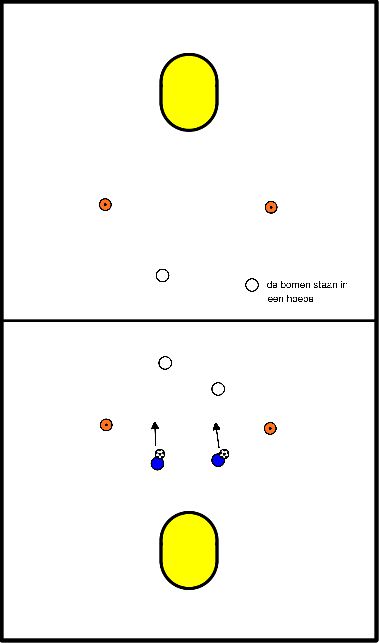
Assignment:
- As the attacking team, try to score in the basket for 2 points or by standing in the hoop with the al for 1 point.
- You are allowed to walk with the ball without being tapped with the ball in your hands.
- Passing and walking with the ball is important!
- It's kind of like rugby, but without physical contact.
Rules:
- You may run with the ball in your hands inside the field
- Defending goals is allowed (tapping the attacking side is smarter)
- Only if you have the ball, you may be tapped.
- Step 1:
- If you are tapped with the ball, you have 2 seconds to throw the ball over.
- If you don't, put the ball on the ground and the defending team attacks.
- Step 2:
- If you are tapped with the ball, you immediately put the ball on the ground and the defending side attacks.
- The 1st pass may not be defended or tapped.
- Scoring in the hoop is 1 point.
- You score in the hoop by standing in it with the ball.
- Scoring in the basket is 2 points.
- Further normal korfball rules.
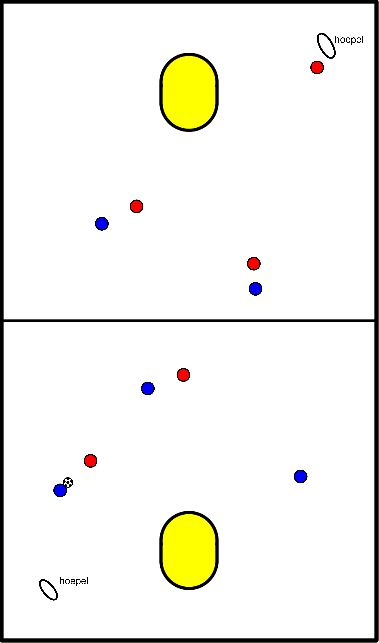
Step 1:
- As a hunter duo, try to move yourself around the field, playing over and throwing off as many runners as possible within 1 minute.
Step 2:
- Try to take the ball away from the hunters as quickly as possible, play over and score in the basket, but be careful not to get tapped by the hunters.
- This is allowed when you have the ball in your hands.
Rules:
- Lay the hats down in a square with approx 5m between the hats.
- Two players are the tappers, the rest move inside the square.
- The two scapegoats are allowed to scapegoat the other players with the ball. The catchers are not allowed to walk with the ball.
- By throwing over the ball the taggers can tap the other players.
- If you are tagged or left outside the box, you are out and you can join again if you have scored a goal.
- At step 1 the runners are not allowed to touch the ball of the hunters.
Variation:
- When players are out, they belong to the tag team instead of being out of the box.
- This is only allowed after they have scored.
- More or less players and therefore more or less balls.
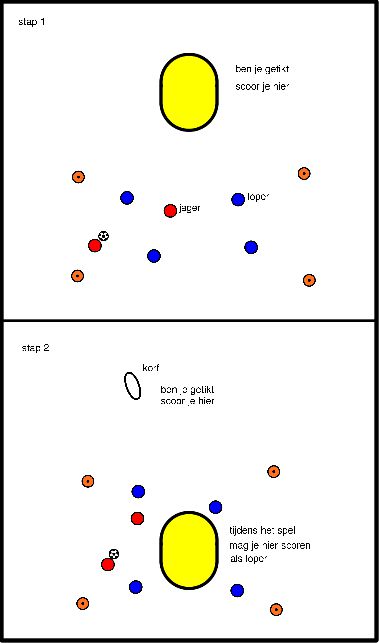
Task:
- Try to get the ball as fast as possible and throw someone off.
- If you are thrown off yourself, try to come back as soon as possible by scoring in the basket outside the field.
Rules of the game:
- If you throw the ball on the body, the player is out:
- Via the ground or a teammate is not a throw-off.
- When you're out, you score in one of the baskets that are outside the field.
- Scored? Put the ball back where it came from and back in the field.
- Count the number of players that are thrown off within a certain time.
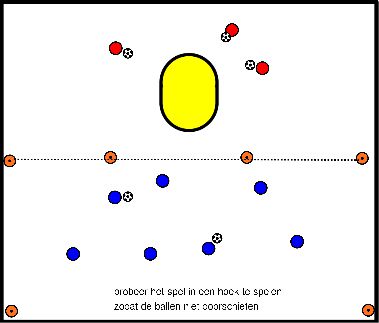
Task:
- Who is the first to circle the ball or the player?
Rules:
- Everyone stands in a circle with enough space to throw a ball quickly.
- The ball starts to the right of the child who is going to run.
- The child who is going to run, runs at the same time as throwing the first ball on the outside of the circle.
- Play the ball deep into the box.
- The one who plays the ball takes the catch.
- The second lady passes the ball on to one of the other players and uses the block near the post to pass.
- The player with the ball plays the ball in and the other lady makes at that moment a breakthrough or dodge and shoots.
- The one who catches the ball puts out to the fans again.
- She then goes to the post again to catch.
- If the position is taken and it is not possible to shoot, the next passer comes in to pass.
- After receiving the ball, she passes it out, etc.
- We practice this first without an opponent and then with an opponent.








